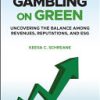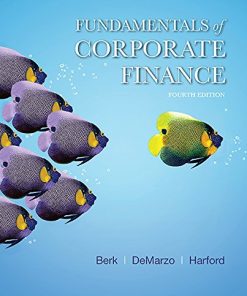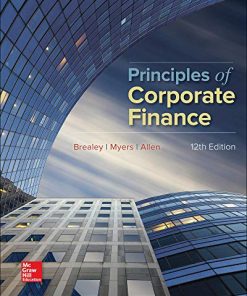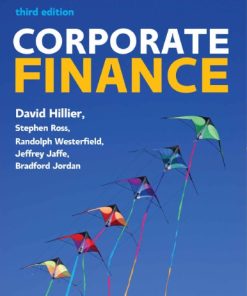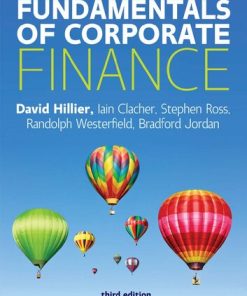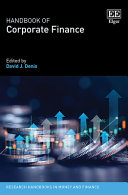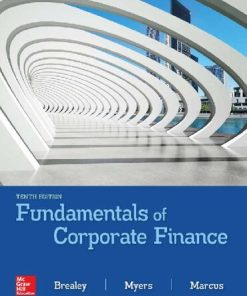Principles of Corporate Finance 14th Edition by Richard Brealey, Stewart Myers, Franklin Allen, Alex Edmans 1266032806 9781266032806
$50.00 Original price was: $50.00.$25.00Current price is: $25.00.
Principles of Corporate Finance 14th Edition by Richard Brealey, Stewart Myers, Franklin Allen, Alex Edmans – Ebook PDF Instant Download/DeliveryISBN: 1266032806, 9781266032806
Full download Principles of Corporate Finance 14th Edition after payment.
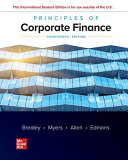
Product details:
ISBN-10 : 1266032806
ISBN-13 : 9781266032806
Author: Richard Brealey, Stewart Myers, Franklin Allen, Alex Edmans
Principles of Corporate Finance describes the theory and practice of corporate finance. Financial managers are shown how to use financial theory to solve practical problems. The text also demonstrates how managers use financial theory to solve practical problems. The new co-author, Alex Edmans, Professor of Finance at London Business School and Mercers School Memorial Professor of Business at Gresham College was also named Poets & Quants MBA Professor of the Year.
Principles of Corporate Finance 14th Table of contents:
Part One: Value
1 Introduction to Corporate Finance
1-1 Corporate Investment and Financing Decisions
Investment Decisions
Financing Decisions
What Is a Corporation?
The Role of the Financial Manager
1-2 The Financial Goal of the Corporation
Shareholders Want Managers to Maximize Market Value
A Fundamental Result: Why Maximizing Shareholder Wealth Makes Sense
Should Managers Maximize Shareholder Wealth?
The Investment Trade-Off
Agency Problems and Corporate Governance
1-3 Key Questions in Corporate Finance
Key Takeaways
Problem Sets
Solutions to Self-Test Questions
Appendix: Why Maximizing Shareholder Value Makes Sense
2 How to Calculate Present Values
2-1 How to Calculate Future and Present Values
Calculating Future Values
Calculating Present Values
Valuing an Investment Opportunity
Net Present Value
Risk and Present Value
Present Values and Rates of Return
Calculating Present Values When There Are Multiple Cash Flows
The Opportunity Cost of Capital
2-2 How to Value Perpetuities and Annuities
How to Value Perpetuities
How to Value Annuities
Valuing Annuities Due
Calculating Annual Payments
Future Value of an Annuity
2-3 How to Value Growing Perpetuities and Annuities
Growing Perpetuities
Growing Annuities
2-4 How Interest Is Paid and Quoted
Continuous Compounding
Key Takeaways
Problem Sets
Solutions to Self-Test Questions
Finance on the Web
3 Valuing Bonds
3-1 Using the Present Value Formula to Value Bonds
A Short Trip to Paris to Value a Government Bond
Back to the United States: Semiannual Coupons and Bond Prices
3-2 How Bond Prices Vary with Yields
Duration and Interest-Rate Sensitivity
3-3 The Term Structure of Interest Rates
Spot Rates, Bond Prices, and the Law of One Price
Measuring the Term Structure
Why the Discount Factor Declines as Futurity Increases
3-4 Explaining the Term Structure
Expectations Theory of the Term Structure
Interest Rate Risk
Inflation Risk
3-5 Real and Nominal Interest Rates
Indexed Bonds and the Real Rate of Interest
What Determines the Real Rate of Interest?
Inflation and Nominal Interest Rates
3-6 The Risk of Default
Corporate Bonds and Default Risk
Sovereign Bonds and Default Risk
Key Takeaways
Further Reading
Problem Sets
Solutions to Self-Test Questions
Finance on the Web
4 Valuing Stocks
4-1 How Stocks Are Traded
Trading Results for Cummins
Market Price vs. Book Value
4-2 Valuation by Comparables
4-3 Dividends and Stock Prices
Dividends and Capital Gains
Two Versions of the Dividend Discount Model
4-4 Dividend Discount Model Applications
Using the Constant-Growth DCF Model to Set Water, Gas, and Electricity Prices
DCF Models with Two or More Stages of Growth
4-5 Income Stocks and Growth Stocks
Calculating the Present Value of Growth Opportunities for Establishment Electronics
4-6 Valuation Based on Free Cash Flow
Valuing the Concatenator Business
Valuation Format
Estimating Horizon Value
Key Takeaways
Problem Sets
Solutions to Self-Test Questions
Finance on the Web
Mini-Case: Reeby Sports
5 Net Present Value and Other Investment Criteria
5-1 A Review of the Net Present Value Rule
Net Present Value’s Competitors
Five Points to Remember about NPV
5-2 The Payback and Accounting Rate of Return Rules
The Payback Rule
Accounting Rate of Return
5-3 The Internal Rate of Return Rule
Calculating the IRR
The IRR Rule
Pitfall 1—Lending or Borrowing?
Pitfall 2—Multiple Rates of Return
Pitfall 3—Mutually Exclusive Projects
Pitfall 4—What Happens When There Is More Than One Opportunity Cost of Capital
The Verdict on IRR
5-4 Choosing Capital Investments When Resources Are Limited
How Important Is Capital Rationing in Practice?
Key Takeaways
Further Reading
Problem Sets
Solutions to Self-Test Questions
Mini-Case: Vegetron’s CFO Calls Again
6 Making Investment Decisions with the Net Present Value Rule
6-1 Forecasting a Project’s Cash Flows
Rule 1: Discount Cash Flows, Not Profits
Rule 2: Discount Incremental Cash Flows and Ignore Non-Incremental Cash Flows
Rule 3: Treat Inflation Consistently
Rule 4: Separate Investment and Financing Decisions
Rule 5: Forecast Cash Flows after Taxes
6-2 Corporate Income Taxes
Depreciation Deductions
Tax on Salvage Value
Tax Loss Carry-Forwards
6-3 A Worked Example of a Project Analysis
The Three Components of Project Cash Flows
Cash Flow from Capital Investment
Operating Cash Flow
Investment in Working Capital
How to Construct a Set of Cash Flow Forecasts: An Example
Capital Investment
Operating Cash Flow
Investment in Working Capital
Accelerated Depreciation and First-Year Expensing
Project Analysis
6-4 How to Choose between Competing Projects
Problem 1: The Investment Timing Decision
Problem 2: The Choice between Long- and Short-Lived Equipment
Problem 3: When to Replace an Old Machine
Problem 4: Cost of Excess Capacity
Key Takeaways
Further Reading
Problem Sets
Solutions to Self-Test Questions
Mini-Case: New Economy Transport (A)
New Economy Transport (B)
Part Two: Risk
7 Introduction to Risk, Diversification, and Portfolio Selection
7-1 The Relationship between Risk and Return
Over a Century of Capital Market History
Using Historical Evidence to Evaluate Today’s Cost of Capital
7-2 How to Measure Risk
Variance and Standard Deviation
Calculating Risk
Estimating Future Risk
7-3 How Diversification Reduces Risk
Specific and Systematic Risk
Diversification with Many Stocks
7-4 Systematic Risk Is Market Risk
Portfolio Choice with Borrowing and Lending
Market Risk
7-5 Should Companies Diversify?
Key Takeaways
Further Reading
Problem Sets
Solutions to Self-Test Questions
Finance on the Web
8 The Capital Asset Pricing Model
8-1 Market Risk Is Measured by Beta
The Market Portfolio
Why Betas Determine Portfolio Risk
8-2 The Relationship between Risk and Return
What If a Stock Did Not Lie on the Security Market Line?
The Capital Market Line and the Security Market Line
The Logic behind the Capital Asset Pricing Model
Intuition: Why Do High Beta and High Returns Go Together?
Applying the Capital Asset Pricing Model
8-3 Does the CAPM Hold in the Real World?
How Large Is the Return for Risk?
Are Returns Unrelated to All Other Characteristics?
8-4 Some Alternative Theories
Arbitrage Pricing Theory
A Comparison of the Capital Asset Pricing Model and Arbitrage Pricing Theory
The Three-Factor Model
Key Takeaways
Further Reading
Problem Sets
Solutions to Self-Test Questions
Finance on the Web
9 Risk and the Cost of Capital
9-1 Company and Project Costs of Capital
Company Cost of Capital for CSX
Three Warnings
What about Investments That Are Not Average Risk?
Perfect Pitch and the Cost of Capital
9-2 Estimating Beta and the Company Cost of Capital
Estimating Beta
Portfolio Betas
9-3 Analyzing Project Risk
1. The Determinants of Asset Betas
2. Don’t Be Fooled by Diversifiable Risk
3. Avoid Fudge Factors in Discount Rates
Discount Rates for International Projects
9-4 Certainty Equivalents
Key Takeaways
Further Reading
Problem Sets
Solutions to Self-Test Questions
Finance on the Web
Mini-Case: The Jones Family Incorporated
Part Three: Best Practices in Capital Budgeting
10 Project Analysis
10-1 Sensitivity and Scenario Analysis
Value of Information
Limits to Sensitivity Analysis
Stress Tests and Scenario Analysis
10-2 Break-Even Analysis and Operating Leverage
Break-Even Analysis
Operating Leverage
10-3 Real Options and the Value of Flexibility
The Option to Expand
The Option to Abandon
Production Options
Timing Options
More on Decision Trees
Pro and Con Decision Trees
Key Takeaways
Further Reading
Problem Sets
Solutions to Self-Test Questions
Mini-Case: Waldo County
11 How to Ensure That Projects Truly Have Positive NPVs
11-1 Behavioral Biases in Investment Decisions
11-2 Avoiding Forecast Errors
11-3 How Competitive Advantage Translates into Positive NPVs
11-4 Marvin Enterprises Decides to Exploit a New Technology—An Example
Forecasting Prices of Gargle Blasters
The Value of Marvin’s New Expansion
Alternative Expansion Plans
The Value of Marvin Stock
The Lessons of Marvin Enterprises
Key Takeaways
Further Reading
Problem Sets
Solutions to Self-Test Questions
Mini-Case: Ecsy-Cola
Part Four: Financing Decisions and Market Efficiency
12 Efficient Markets and Behavioral Finance
12-1 Differences between Investment and Financing Decisions
NPV Matters for Both Investment and Financing Decisions
The NPV of Financing Decisions Is Zero in Efficient Markets
The NPV of Financing Decisions in Inefficient Markets
12-2 The Efficient Market Hypothesis
Forms of Market Efficiency
Why Do We Expect Markets to Be Efficient?
12-3 Implications of Market Efficiency
What Market Efficiency Does Not Imply
What if Markets Are Not Efficient? Implications for the Financial Manager
12-4 Are Markets Efficient? The Evidence
Weak-Form Efficiency
Semistrong-Form Efficiency
Strong-Form Efficiency
12-5 Behavioral Finance
Sentiment
Limits to Arbitrage
Agency and Incentive Problems
Key Takeaways
Further Reading
Problem Sets
Solutions to Self-Test Questions
Finance on the Web
13 An Overview of Corporate Financing
13-1 Patterns of Corporate Financing
How Much Do Firms Borrow?
13-2 Equity
Ownership of the Corporation
Preferred Stock
13-3 Debt
The Different Kinds of Debt
A Debt by Any Other Name
13-4 The Role of the Financial System
The Payment Mechanism
Borrowing and Lending
Pooling Risk
Information Provided by Financial Markets
13-5 Financial Markets and Intermediaries
Financial Intermediaries
Investment Funds
Financial Institutions
13-6 Financial Markets and Intermediaries around the World
Conglomerates and Internal Capital Markets
13-7 The Fintech Revolution
Payment Systems
Person-to-Person Lending
Crowdfunding
AI/ML Credit Scoring
Distributed Ledgers and Blockchains
Cryptocurrencies
Initial Coin Offerings
Key Takeaways
Further Reading
Problem Sets
Solutions to Self-Test Questions
Finance on the Web
14 How Corporations Issue Securities
14-1 Venture Capital
The Venture Capital Market
14-2 The Initial Public Offering
The Public-Private Choice
Arranging an Initial Public Offering
The Sale of Marvin Stock
The Underwriters
Costs of a New Issue
Underpricing of IPOs
Hot New-Issue Periods
The Long-Run Performance of IPO Stocks
Alternative Issue Procedures
Types of Auction: A Digression
14-3 Security Sales by Public Companies
Public Offers
The Costs of a Public Offer
Rights Issues
Market Reaction to Stock Issues
14-4 Private Placements
Key Takeaways
Further Reading
Problem Sets
Solutions to Self-Test Questions
Finance on the Web
Appendix: Marvin’s New-Issue Prospectus
Part Five: Payout Policy and Capital Structure
15 Payout Policy
15-1 Facts about Payout
How Firms Pay Dividends
How Firms Repurchase Stock
The Information Content of Dividends
The Information Content of Share Repurchases
15-2 Dividends or Repurchases? Does the Choice Affect Shareholder Value?
Dividends or Repurchases? An Example
Stock Repurchases and DCF Valuation Models
Dividends and Share Issues
15-3 Dividend Clienteles
15-4 Taxes and Payout Policy
Empirical Evidence on Payout Policies and Taxes
Alternatives to the U.S. Tax System
15-5 Payout Policy and the Life Cycle of the Firm
The Agency Costs of Idle Cash
Payout and Corporate Governance
Key Takeaways
Further Reading
Problem Sets
Solutions to Self-Test Questions
Finance on the Web
16 Does Debt Policy Matter?
16-1 Financial Leverage and Shareholder Value
16-2 Modigliani and Miller’s Proposition 1
The Law of the Conservation of Value
An Example of Proposition 1
16-3 Leverage and Expected Returns: MM’s Proposition 2
Proposition 2
Leverage and the Cost of Equity
How Changing Capital Structure Affects the Equity Beta
Watch Out for Hidden Leverage
16-4 No Magic in Financial Leverage
Today’s Unsatisfied Clienteles Are Probably Interested in Financial Innovation
Imperfections and Opportunities
16-5 A Final Word on the Cost of Capital
Key Takeaways
Further Reading
Problem Sets
Solutions to Self-Test Questions
Mini-Case: Claxton Drywall Comes to the Rescue
17 How Much Should a Corporation Borrow?
17-1 Debt and Taxes
How Do Interest Tax Shields Contribute to the Value of Stockholders’ Equity?
Recasting Johnson & Johnson’s Capital Structure
MM and Corporate Tax
Corporate and Personal Taxes
17-2 Costs of Financial Distress
Bankruptcy Costs
Evidence on Bankruptcy Costs
Direct versus Indirect Costs of Bankruptcy
Financial Distress without Bankruptcy
Agency Costs of Financial Distress
Risk Shifting: The First Game
Refusing to Contribute Equity Capital: The Second Game
And Three More Games, Briefly
What the Games Cost
Costs of Distress Vary with Type of Asset
17-3 The Trade-Off Theory of Capital Structure
17-4 The Pecking Order of Financing Choices
Debt and Equity Issues with Asymmetric Information
Implications of the Pecking Order
The Bright Side and the Dark Side of Financial Slack
17-5 The Capital Structure Decision
The Evidence
Is There a Theory of Optimal Capital Structure?
Key Takeaways
Further Reading
Problem Sets
Solutions to Self-Test Questions
Finance on the Web
18 Financing and Valuation
18-1 The After-Tax Weighted-Average Cost of Capital
Review of Assumptions
Mistakes People Make in Using the Weighted-Average Formula
18-2 Valuing Businesses
Valuing Rio Corporation
Estimating Horizon Value
Valuation by Comparables
Liquidation Value
WACC vs. the Flow-to-Equity Method
18-3 Using WACC in Practice
Some Tricks of the Trade
Adjusting WACC when Debt Ratios and Business Risks Differ
Three-Step Procedure for Finding WACCs at Different Debt Ratios
Unlevering and Relevering Betas
Calculating Divisional WACCs
The Assumption of a Constant Debt Ratio in the After-Tax WACC
The Modigliani–Miller Formula
18-4 Adjusted Present Value
APV for the Perpetual Crusher
Other Financing Side Effects
APV for Entire Businesses
APV and Limits on Interest Deductions
APV for International Investments
18-5 Your Questions Answered
Key Takeaways
Further Reading
Problem Sets
Solutions to Self-Test Questions
Finance on the Web
Appendix: Discounting Safe, Nominal Cash Flows
A Consistency Check
Part Six: Corporate Objectives and Governance
19 Agency Problems and Corporate Governance
19-1 What Agency Problems Should You Watch Out For?
Reduced Effort
Private Benefits
Overinvestment
Risk Taking
Short-Termism
19-2 Monitoring by the Board of Directors
U.S. and U.K. Boards of Directors
European Boards of Directors
19-3 Monitoring by Shareholders
Voting
Engagement
Exit
19-4 Monitoring by Auditors, Lenders, and Potential Acquirers
Auditors
Lenders
Takeovers
19-5 Management Compensation
Compensation Facts and Controversies
The Structure of CEO Pay
19-6 Government Regimes around the World
Ownership and Control in Japan
Ownership and Control in Germany
Ownership and Control in Other Countries
19-7 Do These Differences Matter?
Public Market Myopia
Growth Industries and Declining Industries
Key Takeaways
Further Reading
Problem Sets
Solutions to Self-Test Questions
Finance on the Web
20 Stakeholder Capitalism and Responsible Business
20-1 Who Are the Stakeholders?
Employees
Customers
Suppliers
Local and Regional Communities
The Environment
The Government
20-2 The Case for Shareholder Capitalism
Government Policy Ensures Companies Will Engage in Socially Responsible Behavior
Maximizing Shareholder Value Allows Investors to Pursue Social Objectives
Maximizing Shareholder Value Requires a Company to Invest in Stakeholders
Enlightened Shareholder Value
Decision Making under Enlightened Shareholder Value
20-3 The Case for Stakeholder Capitalism
Well-Functioning Governments
No Comparative Advantage in Serving Society
Instrumental Decision Making Is Effective
The Challenge of Stakeholder Capitalism
Summary
20-4 Responsible Business
Defining Responsible Business
Decision Making in Responsible Businesses
Summary
20-5 Responsible Business in Practice
Shareholder Primacy in the United States and United Kingdom
Benefit Corporations
B Corps
Purpose
Reporting
Key Takeaways
Further Reading
Problem Sets
Solutions to Self-Test Questions
Finance on the Web
Part Seven: Options
21 Understanding Options
21-1 Calls, Puts, and Shares
Call Options and Payoff Diagrams
Put Options
Selling Calls and Puts
Payoff Diagrams Are Not Profit Diagrams
21-2 Financial Alchemy with Options
Spotting the Option
21-3 What Determines the Value of a Call Option?
Risk and Option Values
Key Takeaways
Further Reading
Problem Sets
Solutions to Self-Test Questions
Finance on the Web
22 Valuing Options
22-1 A Simple Option-Valuation Model
Why Discounted Cash Flow Won’t Work for Options
Constructing Option Equivalents from Common Stocks and Borrowing
Risk-Neutral Valuation
Valuing the Amazon Put Option
Valuing the Put Option by the Risk-Neutral Method
The Relationship between Call and Put Prices
22-2 The Binomial Method for Valuing Options
Example: The Two-Step Binomial Method
The General Binomial Method
The Binomial Method and Decision Trees
22-3 The Black–Scholes Formula
Using the Black–Scholes Formula
How Black-Scholes Values Vary with the Stock Price
The Risk of an Option
The Black–Scholes Formula and the Binomial Method
Some Practical Examples
22-4 Early Exercise and Dividend Payments
Key Takeaways
Further Reading
Problem Sets
Solutions to Self-Test Questions
Finance on the Web
Mini-Case: Bruce Honiball’s Invention
23 Real Options
23-1 The Option to Expand
Questions and Answers about Blitzen’s Mark II
Other Expansion Options
23-2 Options in R&D
23-3 The Timing Option
Valuing the Malted Herring Option
Optimal Timing for Real Estate Development
23-4 The Abandonment Option
Bad News for the Perpetual Crusher
Abandonment Value and Project Life
Temporary Abandonment
23-5 Flexible Production and Procurement
Aircraft Purchase Options
23-6 Valuing Real Options
A Conceptual Problem?
What about Taxes?
Practical Challenges
Key Takeaways
Further Reading
Problem Sets
Solutions to Self-Test Questions
Part Eight: Debt Financing
People also search for Principles of Corporate Finance 14th:
principles of corporate finance 14th edition solutions pdf
principles of corporate finance 10th edition
principles of corporate finance 12th edition
principles of corporate finance 14th edition answers
principles of corporate finance 9th edition
Tags: Principles, Corporate Finance, Richard Brealey, Stewart Myers, Franklin Allen, Alex Edmans
You may also like…
Uncategorized
Business & Economics - Personal Finance
Business & Economics - Accounting
Uncategorized
Uncategorized
Business & Economics
Uncategorized
Business & Economics - Professional Finance


